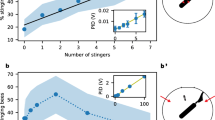Abstract
The paper presents the findings of the research that attempted to mathematically model the cognitive behavior that could arise due to the interaction between honeybees in a colony during forager recruitment process. The model defines a honeybee as a spiking neural network, and colony as a network of spiking neural networks. The proposed mathematical model has been evaluated by analyzing the cognitive behavior generated by the main network which represents honeybees’ interaction as interactions of component networks (i.e. spiking neural networks). Accordingly, behavior of the component network, that represents an unemployed forager in the colony, was examined under different scenarios by setting networks’ parameters to simulate ecological situations in the colony. The reporting of different level of quantity of nectar sources by scouts to the colony, an attempt made by a scout to attract more unemployed foragers for foraging, and influence by dancing foragers to attract other unemployed foragers for foraging are those ecological colony states that have been tested in this research. The results of all these cases have supported that the proposed mathematical model can sufficiently simulate the unemployed forager’s behavior during recruitment process.






Similar content being viewed by others
Explore related subjects
Discover the latest articles, news and stories from top researchers in related subjects.References
Trianni V, Tusi E (2011) Swarm cognition and artificial life, advances in artificial life. Darwin meets von Neumann. Lect Notes Comput Sci 5778:270–277
Ahmed H, Glasgow J 2012 Swarm intelligence: concepts, models and applications. Technical Report 2012-585, School of Computing, Queen’s University, Canada
Blum C (2005) Ant colony optimization: Introduction and recent trends. Phys Life Rev 2:353–373
Karaboga D, Akay B (2009) A survey: algorithms simulating bee swarm intelligence. Artif Intell Rev 31(1):68–85
Krink T Swarm intelligence—introduction, EVALife Group, Department of Computer Science, University of Aarhus
Myerscough MR (2003) Dancing for a decision: a matrix model for nest-site choice by honeybees. Proc R Soc Lond 270(1515):577–582
Bailis P, Nagpal R, Werfel J (2010) Positional Communication and Private Information in Honeybee Foraging Models. In: Dorigo M. et al. (eds) Swarm Intelligence. ANTS 2010. Lecture Notes in Computer Science, vol 6234. Springer, Berlin, Heidelberg
Trianni V, Tusi E, Passino EM, Marshell JAR (2011) Swarm cognition: an interdisciplinary approach to the study of self-organizing biological collectives. Swarm Intell 5:3–18
Fernando S, Kumarasinghe N (2015) Modeling a honeybee using spiking neural network to simulate nectar reporting behavior. Int J Comput Appl 130–138:33–39
Gil M (2010) Reward expectations in honeybees. Commun Integr Biol 3(2):95–100
Seeley TD, Mikheyev AS, Pagano GJ (2000) Dancing bees tune both duration and rate of waggle-run production in relation to nectar-source profitability. J Comp Physiol [A] 186(9):813–819
Yahya H (2007) The miracle of the Honeybee. Ch. 2–3, Global Publishing
Thom C (2003) The tremble dance of honey bees can be caused by hive-external foraging experience. J Exp Biol 206(Pt 13):2111–2116
Seeley TD (1992) The tremble dance of the honey bee: message and meanings. Behav Ecol Sociobiol 31(6):375–383
Passino KM, Seeley TD (2006) Modeling and analysis of nest-site selection by honeybee swarms: the speed and accuracy trade-off. Behav Ecol Sociobiol 59(3):427–442
Bressan JMA, Benz M, Oettler J, Heinze J, Hartenstein V, Sprecher SG (2014) A map of brain neuropils and fiber systems in the ant Cardiocondyla obscurior. Front Neuroanat 8:166
Michener CD (1974) The social behavior of the bees: a comparative study. Harvard Univ. Press., Cambridge
Tautz J, Maier S, Groh C, Rossler W, Brockmann A (2003) Behavioral performance in adult honey bees is influenced by the temperature experienced during their pupal development. Proc Natl Acad Sci USA 100(12):7343–7347
Sinakevitch I, Mustard JA, Smith BH (2011) Distribution of the octopamine receptor AmOA1 in the honey bee brain. PLoS One 6(1):e14536. https://doi.org/10.1371/journal.pone.0014536
Izhikevich EM (2003) Simple model of spiking neurons. IEEE Trans Neural Netw 14(6):1569–1572
Fernando S (2014) Modeling function of nectar foraging of honeybees using operant conditioning. Int J Comput Appl 104:45–51
Quintavalle A (2013) Voltage-gated calcium channels in honey bees: physiological roles and potential targets for insecticides. BioSciences Master Reviews pp 1–11
Perk CG, Mercer AR (2006) Dopamine modulation of honey bee (Apis mellifera) antennal-lobe neurons. J Neurophysiol 95:1147–1157
Fernando S, Yamada K, Marasinghe A (2011) Observed stent’s anti-hebbian postulate on dynamic stochastic computational synapses. In: Proceedings of International Joint Conference on Neural Network, pp. 1336–1343
Abbott LF, Nelson SB 2000 Synaptic Plasticity: taming the beast. Neuroscience 3:1178–1183
Izhikevich EM (2007) Dynamical systems in neuroscience: the geometry of excitability and bursting. Ch 8, MIT Press
Author information
Authors and Affiliations
Corresponding author
About this article
Cite this article
Fernando, S., Kumarasinghe, N. Modeling honeybee communication using network of spiking neural networks to simulate nectar reporting behavior. Artif Life Robotics 23, 241–248 (2018). https://doi.org/10.1007/s10015-017-0418-6
Received:
Accepted:
Published:
Issue Date:
DOI: https://doi.org/10.1007/s10015-017-0418-6




